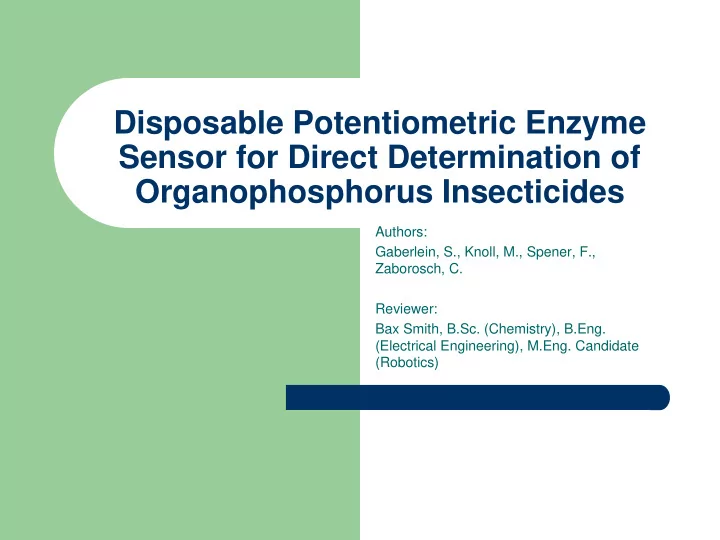

Disposable Potentiometric Enzyme Sensor for Direct Determination of Organophosphorus Insecticides Authors: Gaberlein, S., Knoll, M., Spener, F., Zaborosch, C. Reviewer: Bax Smith, B.Sc. (Chemistry), B.Eng. (Electrical Engineering), M.Eng. Candidate (Robotics)
Outline � Development of the Disposable Sensor for OP – Why?, Preparation, Structure, Double Matrix Membranes (DMM) � OP Disposable Sensor Performance – Effect of enzyme loading, starting pH, buffer concentration and temperature – Calibration Results – Specificity, reproducibility, precision and long term storage stability � Advantages/DisAvantages
Development of a Disposable Sensor for OP
Why? � Organophosphorus Compounds are very toxic and are widely used in insecticides – Results in irreversible inhibition of acetylcholinesterase (AChE) in both target organisms and non-target organisms (mammals) � Detection Techniques – GC, LC and TLC work well but are time consuming and expensive – Biosensors based on inhibition of cholinesterase activity usually require long incubation times and long regeneration times
The Solution � A Biosensor based on the hydrolytic cleavage reaction of organophosphorus hydrolase (OPH) – OPH hydrolyzes a wide range of OP esters – Hydrolysis of one OP molecule releases 2 protons from the products
Preparation � OPH isolated from E. coli DH5 � cells � Construct Sensor � Double Matrix Membrane (DMM) – 1% N,N-dioctadecylmethylamine (H+-ionophore), 67% bis(2-ethylhexyl)sebacate, 0.3% sodium tetraphenlyborate, 31.7% PVC dissolved in tetrahydrofuran and cyclohexanone � Enzyme Sensors – Poly(carbamoyl sulfonate) PCS + OPH drops polymerize adjacent to DMM � Dip in buffer with 100mM Sodium Chloride to fill reference electrode filter paper
Structure - Side
Structure – Front/Back
OP Disposable Sensor Performance
pH Calibration � pH calibration of 10 electrodes gave a slope with mean value 55.2 mV/decade (SD = 1.9%) over pH range 11 to 6 – Acceptable value is 48, Nernst value is 59
Effect of Enzyme Loading
Effect of Buffer Concentration
Calibrations with OP Compounds
Specificity
Reproducibility, Precision and Long Term Storage Stability � Reproducibility: � E values for 10 sensors had SD of 1.1% � Precision: repeated use of one sensor had SD of 0.75% (n=5)
Advantages/Disadvantages � Fast � Higher detection limits (uM vs nM) � Inexpensive � Very sensitive to buffer � Easy to handle concentration
Conclusion � Very well suited to sewage and subsoil water samples where the content of buffering substances are low
Recommend
More recommend